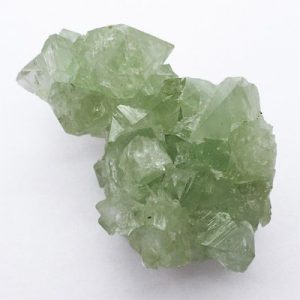Hydroxylherderite
Hydroxylherderite is a calcium that is rare phosphate mineral that typically occurs in pegmatite deposits as small, unimpressive crystals in many different colors including gray, brown, pale yellow, greenish white, light blue, purple and colorless. Hydroxylherderite is the analog that is hydroxyl-dominant of. Most specimens labeled “Herderite” are in reality Hydroxylherderite. Hydroxylherderite was named “Hydro-Herderite” in 1894 by Samuel L. Penfield. The name was changed to “Hydroxyl-Herderite” by Palache, Berman, and Frondel in 1954 and renamed Hydroxylherderite by Mineralogical Record (v39, 2008, p131). It had been originally called for Siegmund Wolfgang von Herder (1776-1838), Mining official in Freiberg, Germany August. The “Hydroxyl” prefix signifies the dominance of hydroxide over fluorine.
Areas for Hydroxylherderite: Many localities, but unusual at many. Some of the analyzed material include: in the USA, in Maine, at Paris, Hebron, Greenwood, Stoneham, and Newry, Oxford County, at Topsham, Sagadahoc County, Poland and Auburn, Androscoggin County, and elsewhere; in the Fletcher and Palermo #1 mines, near North Groton, Grafton County, and at the Keyes mine, Orange, Grafton County, New Hampshire; from the Blue Chihuahua pegmatite, near Oak Grove, Hillcrest County, California. In Germany, at the Epprechtstein and Waldheim quarries, Fichtelgebirge, Bavaria. In the Viitaniemi pegmatite, near Eräjärvi, Finland. From Mursinsk, Ural Mountains, Russia. At Ungursuay, Kazakhstan. In Brazil, large crystals through the Xandá mine, Virgem da Lapa, and during the Golconda mine, near Governador Valadares, Minas Gerais.
| Category: | Phosphate mineral |
| Chemical Formula: | CaBe(PO4)(OH) |
| Calcium Beryllium Phosphate Hydroxide | |
| Molecular Weight: | 161.07 gm |
| Composition: | Calcium | 24.88 % | Ca | 34.82 % | CaO |
| Beryllium | 5.60 % | Be | 15.53 % | BeO | |
| Phosphorus | 19.23 % | P | 44.06 % | P2O5 | |
| Hydrogen | 0.63 % | H | 5.59 % | H2O | |
| Oxygen | 49.67 % | O | |||
| 100.00 % | 100.00 % | = TOTAL OXIDE |
| Crystallography: | Monoclinic – Prismatic |
| Crystal Habit: | As stout prismatic crystals, elongated along [001] or [100], may be thick tabular {001}, typically with complex but rounded form development, to 17 cm; botryoidal to spherical, radial fibrous, in aggregates. |
| Twinning: | On {100} or {001} or both, as “fishtail” contact twins, common |
| Cleavage: | Poor/Indistinct on {110} |
| Fracture: | Irregular/Uneven |
| Tenacity: | Brittle |
| Moh’s Hardness: | 5.0 – 5.5 |
| Density: | 2.95 (g/cm3) |
| Luminescence: | May fluoresce weak yellow under SW UV, sometimes with bright yellow-orange phosphorescence. |
| Radioactivity: | Not Radioactive |
| Other: | Soluble in acids |
| Color: | Colorless, gray, brown, pale yellow, greenish white, light blue, purple; colorless in transmitted light; may be blue-green or blue in daylight, lavender or light violet in incandescent light. |
| Transparency: | Transparent to translucent |
| Luster: | Vitreous to subvitreous, resinous |
| Refractive Index: | 1.589 – 1.643 Biaxial ( – ) |
| Birefringence: | 0.030 |
| Dispersion: | r > v, inclined |
| Pleochroism: | None |


